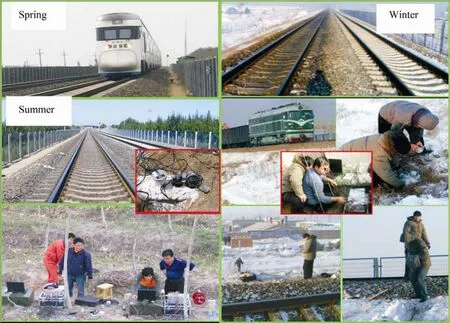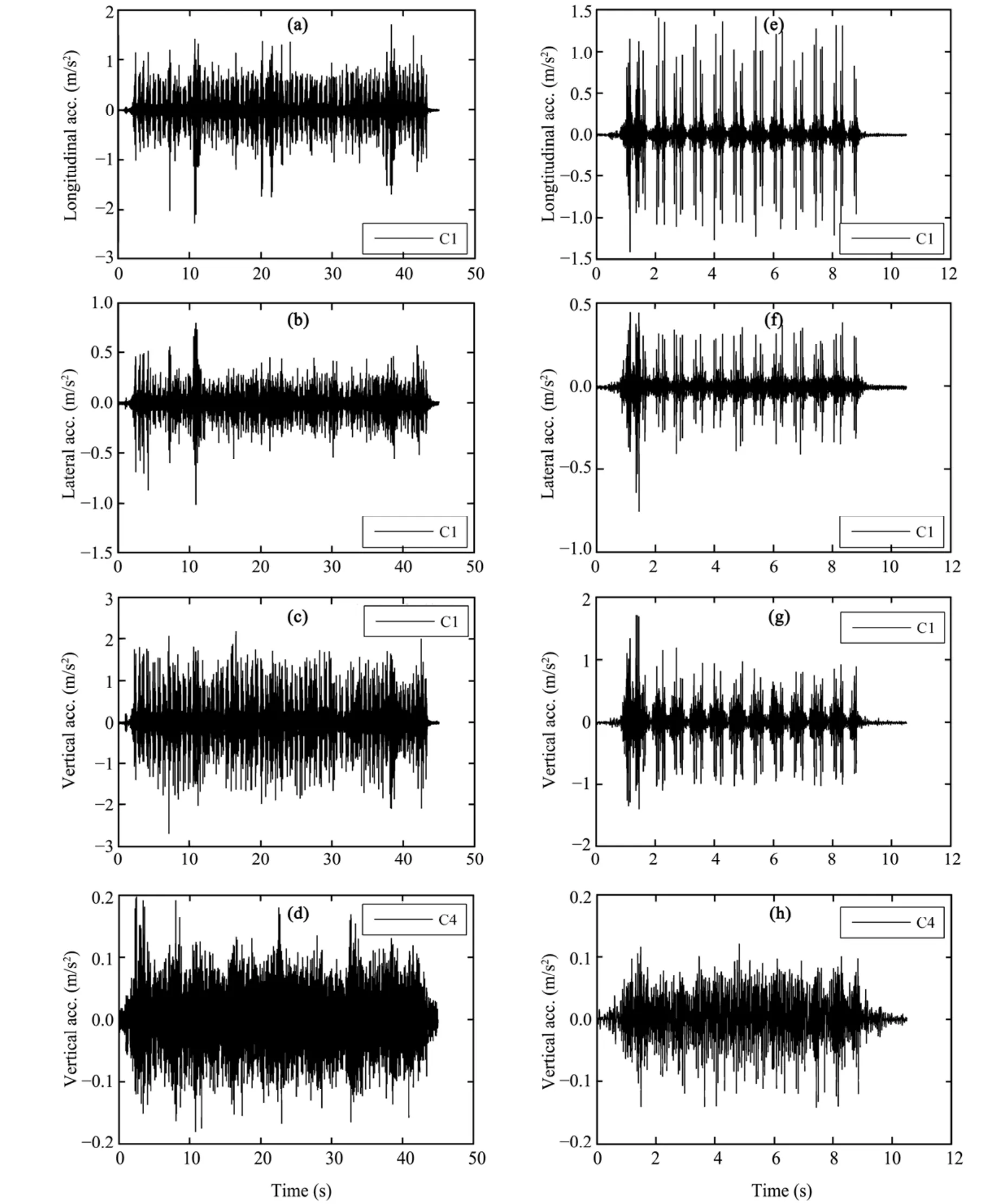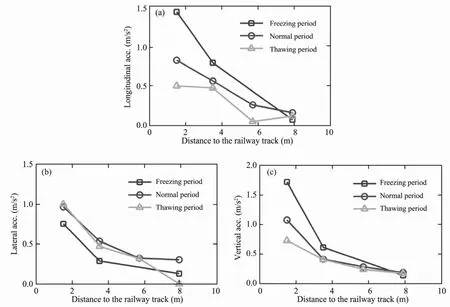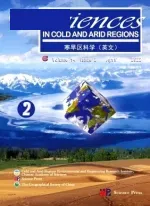Field monitoring of railroad embankment vibration responses in seasonally frozen regions
ZiYu Wang , XianZhang Ling , Feng Zhang , LiNa Wang , ShiJun Chen , ZhanYuan Zhu
1. School of Civil Engineering, Harbin Institute of Technology, Harbin, Heilongjiang 150090, China
2. State Key Laboratory of Frozen Soils Engineering, Chinese Academy of Sciences, Lanzhou, Gansu 730000, China
3. School of Transportation Science and Engineering, Harbin Institute of Technology, Harbin, Heilongjiang 150090, China
4. School of Civil Engineering, East China Institute of Technology, Nanchang, Jiangxi 330013, China
5. Urban and Rural Construction College, Sichuan Agricultural University, Dujiangyan, Sichuan 611830, China
1 Introduction
In China, about 5.14 million km2area is covered by seasonally frozen soil. Seasonally frozen soil with a freezing depth of more than 0.5 m covers 4.46 million km2. In recent years, as passenger train speeds have increased and freight train loads have become heavier, the research on train-induced vibration response has received considerable attention. Several researchers have performed field experiments to investigate the ground vibration induced by passing trains (Mao, 1987; Juet al., 2007; Linget al., 2009; Linget al., 2010), and many theoretical methods and numerical simulation models have been developed and verified by field measurements (Amir, 2000; Juet al., 2007; Coulieret al.,2013; El Kacimiet al., 2013).
This paper reports on our investigation of the vibration characteristics of a railway subgrade in different seasons.Three field experiments were carried out along the Daqing-Harbin Railway in the Daqing seasonally frozen region during normal, freezing, and thawing periods. The attenuation of the subgrade vibration was studied based on the defined characteristic accelerations produced by three types of trains (the slow-speed passenger train K129, the high-speed passenger train T507, and a freight train) in spring, summer, and winter. Finally, the influences of the season, train speed, train type, and train load on the subgrade vibration were evaluated and conclusions are presented here that provide insight on the characteristics and extent of subgrade vibration.
2 Information of the monitoring field
The field monitoring site is situated at section K124+118(i.e., 124 km and 118 m from Harbin) of the Harbin-Daqing Railway within Heilongjiang Province, in northeastern China. Figure 1 illustrates the monitoring site. In Daqing City,the freezing period lasts from October to mid-March of the following year, and the thawing period lasts from mid-March to May; the other four months are considered to be the unfrozen period. The highest temperature is 37 °C in summer, and the lowest temperature reaches -35 °C in winter. The maximum seasonal frost depth and the ground water table are both about 2 m below the ground surface.
At the experimental site, four measuring points were arranged on a cross section of the railway track. C1 was established at the shoulder of the railway, C2 was at the surface layer of the subgrade, C3 was at the bottom layer of the subgrade, and C4 was at the foundation. At each measuring point, three accelerometers were installed to measure the three directions of the subgrade vibration (vertical, lateral,and longitudinal). The lateral distances to the railway track of each measuring point are shown in Figure 2.

Figure 1 Overview of the experimental site

Figure 2 Schematic of acceleration monitoring on the Daqing-Harbin Railway
3 Time histories of acceleration response
Figure 3 shows acceleration time histories induced by a freight train [v= 68 km/h, train formation 1+56 (1 locomotive and 56 compartments)] and the high-speed passenger train T507 [v= 140 km/h, train formation 1+10 (1 locomo-tive and 10 compartments)] at points C1 and C4 in the vertical direction (Z), the lateral direction (Y), and the longitudinal direction (X) in the freezing period.
Figures 3a, b, c, e, f, g show the time histories of the acceleration response cycles, which are very visible from the measurements at C1; the repetitive action of the train wheels can be easily distinguished. With increasing distance from the railway track, the time histories of the acceleration response cycles were not evident from the measurements at C4, and the repeated action of the train wheels cannot be easily distinguished from Figures 3d and 3h. The reason for this is that with greater acceleration amplitude, the acceleration attenuated more rapidly.
Comparison of acceleration time histories induced by these trains in the three directions and at the different monitoring points shows that the acceleration amplitude induced by the freight train was greater than by the passenger train in all directions and monitoring points in the freezing period.

Figure 3 Acceleration time histories induced by a freight train (left) and a passenger train (right) in the longitudinal, lateral, and vertical directions
4 The relationship between acceleration and attenuation
4.1 Definition of the maximum absolute acceleration
To describe the statistical characteristics of the subgrade vibration induced by a passing train, the maximum absolute acceleration|aij|maxis defined as follows:

where, the direction parallel to the railway track line is defined as the longitudinal direction,X; the direction perpendicular toXdirection is defined as the lateral direction,Y; the direction upright to the ground level is the vertical direction,Z; and the number of collected data by the passing train,N.
4.2 Vibration response in three directions
Figure 4 shows acceleration amplitude and attenuation characteristics decreasing with the increasing distance from the railway track in the three directions in spring, summer, and winter. At measuring point C1 in winter, the acceleration amplitude in the vertical direction was the greatest (about 1.8 m/s2)and the lateral vibration was the lowest (about 0.8 m/s2); in summer the acceleration amplitude in the vertical direction was the greatest (about 1.2 m/s2) and the longitudinal vibration was the lowest (about 0.8 m/s2); and in spring the acceleration amplitude in the lateral direction was the greatest (about 1.0 m/s2) and the longitudinal vibration was the lowest(about 0.5 m/s2). As shown in Figures 5a and 5b, in the freezing and unfrozen periods, the acceleration amplitude and attenuation rates in all three directions, all decreased as the distance from the railway track increased. And Figure 5c shows in the thawing period, the acceleration amplitude in all three directions decreased as the distance from the railway track increased, but the attenuation rate was uncertain in the lateral and longitudinal directions from the point C1 to C4.

Figure 4 Acceleration amplitude attenuations in the three directions in the unfrozen period (passenger train formation 1+10, v = 140 km/h)(a) freezing period, (b) unfrozen period, (c) thawing period
4.3 Influences of train formation, train type, and travel speed
The acceleration amplitudes as measured at the different monitoring points, and the attenuation relationship with the distance from the railway track of different train formations,train types, travel speeds and train loads, in the unfrozen period are shown in Figure 5. The figure illustrates that the acceleration amplitudes and the attenuation rates both decreased with increasing distance from the railway track in the three directions.
The acceleration amplitudes in the three directions were influenced by the train type, train formation, travel speed and train load. Figures 5a and 5c show that the acceleration amplitude of the freight train was greater than that of the passenger train in the vertical direction; this is because of its heavier axis load and greater number of compartments than the passenger train. The acceleration amplitude of the passenger train composed of one locomotive and 11 train compartments, and moving at a speed of 68 km/h, was the lowest in the three directions because, even though its number of compartments was similar to the high-speed train (v= 140 km/h), its speed was lower. Figure 5b shows that the acceleration amplitude of the high-speed train was greater than the freight train, possibly because speed was the most important effect factor in the lateral direction.
As shown in Figure 5, the vertical vibration was the greatest and the lateral vibration was the lowest at C1, and at C4 the lateral vibration was greater than the vertical vibration. From C1 to C4, the acceleration attenuation rates decreased in the three different directions, with that of the vertical direction being the largest and the lateral direction being the least.

Figure 5 Acceleration attenuation as related to distance from the railway track in the unfrozen period(a) longitudinal direction, (b) lateral direction, (c) vertical direction
4.4 Influence of seasons
To research the seasonal influence on subgrade vibration,the time histories of the acceleration response induced by the high-speed passenger train T507 (v= 140 km/h) in the different experimental periods are shown in Figure 6. Figures 6a, b, c show that the vertical acceleration amplitude at C1 was 1.8 m/s2in the freezing period, significantly greater than in the thawing period (about 0.8 m/s2) and the unfrozen period (about 1.1 m/s2). Affected by low environmental temperatures (< 0 °C) in the freezing period, the subgrade surface water froze, causing the groundwater to migrate upward to a shallow subgrade due to variations in moisture. This results in the pores among the soil particles becoming filled with ice crystals, which changes the dynamic behavior of the embankment soil (Xuet al., 1998). The frozen layer stiffness is greater than unfrozen layer and its damping is little more than that of the unfrozen layer (Xuet al., 1998), which consequently reduces energy dissipation and increases the embankment’s motion response in the vertical direction.
5 Conclusions
Train-induced vibration response is affected by many factors, including train formation, axle load, train load, track unevenness, travel speed, and subgrade conditions. In this paper, the vibration characteristics of various train types and train speeds on the embankment of the Harbin-Daqing Railway in Daqing, China are investigated through monitoring in different seasons. Our conclusions are:

Figure 6 Attenuation of acceleration amplitudes with distance from the railway track in three different seasons(a) longitudinal direction, (b) lateral direction, (c) vertical direction
1) Acceleration amplitudes and attenuation rates decreased as the distance from the railway track increased in the vertical,lateral, and longitudinal directions during the freezing and unfrozen periods.
2) The acceleration amplitudes in the vertical, lateral,and longitudinal directions were influenced by train type,train formation, train speed, and train load. The acceleration amplitude of a freight train was greater than that of a passenger train in the vertical direction. As the speed of passenger trains with similar numbers of train compartments increased, the subgrade vibration increased.
3) The vertical acceleration amplitude at measuring point C1 in the freezing period was significantly greater than in the thawing period and the unfrozen period. The vertical acceleration amplitudes and attenuation rates all decreased with the increasing distance from the railway track in the three seasons,but the trends were uncertain in the lateral and longitudinal directions.
This study was supported by the 973 Program of China(Grant No. 2012CB026104), the National Natural Science Foundation of China (Grant Nos. 51174261 and 51078111),the Open Research Fund Program of the State Key Laboratory of Permafrost Engineering of China (Grant No.SKLFSE201007), and the Ministry of Railways Science and Technology Research and Development Program (Grant No.2009G010-E).
Amir M, Christian M, Peter Z, 2000. Ground vibration from high-speed trains: Prediction and countermeasures. Journal of Geotechnical and Geoenvironmental Engineering, 6: 531–537.
Coulier P, Francois S, Degrande G, Lombaert G, 2013. Subgrade stiffening next to the track as a wave impeding barrier for railway-induced vibrations. Soil Dynamics and Earthquake Engineering, 48: 119–131.
El Kacimi A, Woodward PK, Laghrouche O, Medero G, 2013. Time domain 3D finite element modelling of train-induced vibration at high speed.Computers and Structures, 118: 66–73.
Ju SH, Lin HT, Chen TK, 2007. Studying characteristics of train-induced ground vibrations adjacent to an elevated railway by field experiments.Journal of Geotechnical and Geoenvironmental Engineering, 133(10):1302–1307.
Ling XZ, Chen SJ, Zhu ZY, Zhang F, Wang LN, Zou ZY, 2010. Field monitoring of the train-induced vibration response of track structure in Beiluhe permafrost region along Qinghai-Tibet Railway in China. Cold Regions Science and Technology, 60(1): 75–83.
Ling XZ, Wang LN, Zhang F, Chen SJ, Zhu ZY, 2010. Field experiment on train-induced embankment vibration responses in seasonally frozen regions of Daqing, China. Journal of Zhejiang University–SCIENCE,11(8): 596–605.
Ling XZ, Zhang F, Zhu ZY, Ding L, Hu QL, 2009. Field experiment of embankment vibration induced by passing train in a seasonally frozen region of Daqing. Earthquake Engineering and Engineering Vibration,8(1): 149–157.
Lombaert G, Degrande G, 2009. Ground-borne vibration due to static and dynamic axle loads of intercity and high-speed trains. Journal of Sound and Vibration, 319: 1036–1066.
Mao YQ, 1987. Characteristics and attenuation of ground vibration caused by traffic vehicles. Journal of Building Structures, 1: 67–77.
Xu XY, Zhong CL, Chen YM, Zhang JY, 1998. Research on dynamic characteristics of frozen soil and determination of its parameters. Chinese Journal of Geotechnical Engineering, 20(5): 77–91.
 Sciences in Cold and Arid Regions2013年4期
Sciences in Cold and Arid Regions2013年4期
- Sciences in Cold and Arid Regions的其它文章
- Development of a dynamic load direct shear apparatus for the study of permafrost
- Roadbed, embankment, tower support and culvert stability problems on permafrost
- Different discretization method used in coupled water and heat transport mode for soil under freezing conditions
- Reinforcement effects of ground treatment with dynamic compaction replacement in cold and saline soil regions
- Review of the influence of freeze-thaw cycles on the physical and mechanical properties of soil
- Neumann stochastic finite element method for calculating temperature field of frozen soil based on random field theory
